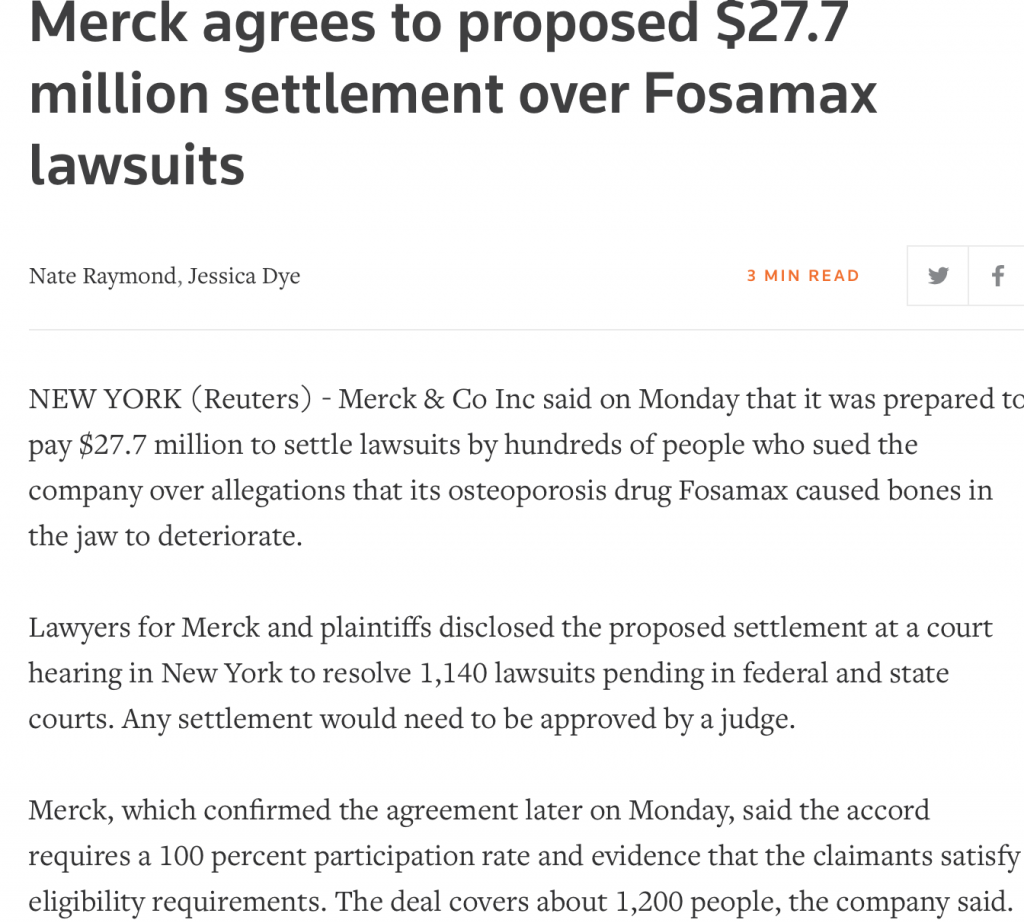Flu shots, Fosamax and pharmaceutical fakery: The common use of misleading and deceptive statistics
11/30/2017 / By News Editors

Several years ago there was a temporary media buzz generated by an October 2011 article in The Lancet Infectious Disease journal, which is a pro-vaccine, pro-pharmaceutical industry medical journal that is published in Britain. The article showed that flu vaccinations were far less effective than had been previously believed. In fact, the study suggested that the trivalent flu vaccine currently being pushed at that time approached worthlessness.
(Article by Dr. Gary G. Kohls republished from GlobalResearch.ca)
The article’s principle author was Michael Osterholm, PhD, MPH, a widely published infectious disease researcher who, prior to his current faculty position at the University of Minnesota, had served in various capacities with the CDC and the Minnesota Department of Health (MDH), including a high-profile role as the MDH’s Chief of the Acute Disease Epidemiology Section. For 15 years of that association with the MDH Osterholm served as Minnesota state epidemiologist. Osterholm has published over 300 articles and is highly respected in his field.
The Disconnect Between Real, Unbiased Science and Profit-focused Corporate Propaganda
The Lancet study, in the reports that I listened to on NPR and read about in various print media reports, was deceptively reported as showing that the trivalent flu vaccines should still be regarded as “moderately effective” for flu prevention rather than being brought into question as the minimally effective vaccine that the article suggested. What could explain the disconnect between the science and the propaganda?
Seeing no sign of a public retraction from Osterholm or his co-authors about the glaring misperceptions, I began to wonder if they were even aware that they had stooped to the depths that so many other medical, psychiatric and pharmaceutical industry researchers have gone to when their articles are published in mainstream medical journals. Misleading statistics that have appeared in medical journals are also used in drug commercials and by drug sales representatives when they try to convince us physicians to prescribe their company’s synthetic drugs.
What I am talking about is the common statistical trick of the trade called the Relative Risk Reduction [RRR], a statistic that intentionally inflates embarrassingly low or even statistically insignificant results that had been obtained from dubious research studies.
What the public deserves to be informed about, but usually doesn’t receive, is the far more meaningful Absolute/Actual Risk Reduction [ARR] numbers, which, compared to the RRR, are often so small and unconvincing that any rational thinker would regard the study as a failed one. Hence, the cunning invention of the misleading RRR. I will deal with the important mathematical differences further below.
The Deceptive Relative Risk Reduction Statistic
A lot of medical research these days is done by academic scientists that may not be clinicians. The vast majority of these researchers, estimated to represent over 80% of the medical research that is currently being done, are in the employ of the for-profit drug and medical device industries. The research articles that list them as authors are frequently written by ghost-writers who are salaried by the corporations that designed and funded the study. And what should worry everybody is the fact that the self-interested corporations have exclusive control over how the research is utilized. Whoever pays the piper, calls the tune.
The researchers involved in such studies are naturally highly motivated to help rapidly get to market the products they are working on, with the additional hope that any positive results that they can generate will increase the value of any stock holdings that may be part of their compensation package. Additional contracts with the pharmaceutical company will be more likely if negatives are not found. I hasten to add that there is nothing wrong with making money in an ethical and honest manner, but a lot of medical research intentionally overstates the positives of the products that are being marketed and minimizes, or even hides, the negatives of their new drugs, vaccines or medical devices.
One of the problems alluded to above is the widespread use of the grossly misleading statistic called the Relative Risk Reduction (RRR). It is important for consumers of new drugs or medical devices to understand the differences between the RRR and the ARR. Usually, if the differences are mentioned at all, they are only noted in the fine print.
The Lancet article that revealed the lack of efficacy of flu shots did indeed report a “60% efficacy rate”, and that phrase was prominently reported in the media, which pointed out the commonly-accepted past estimates of 90% efficacy. The problem was that both the 60% and the 90% figures were intentionally misleading RRR stats. But what wasn’t reported in the media coverage was the fact that the actual risk reduction (ARR) for the flu shots was a miniscule 1.5%. If that figure had been used, people would have balked at consenting to the shot. And, as any honest, non-co-opted, thinking person can see, the difference between the misleading figure of 60% and the real figure of 1.5% is huge – and, as ever, represents just another cunning statistical trick that is used to promote highly profitable products, that, incidentally, can also be toxic.
Blowing the Whistle on Deceptive Advertising in Medicine
Seeing the truth of the matter and hearing the misleading media interpretation, I knew that some somebody needed to blow the whistle. Hence this article.
One of the reasons to be truthful about flu vaccine efficacy is the fact that the benefits for the elderly have been consistently exaggerated over the years, both in the medical literature and in the advertisements by medical clinics, trade associations, departments of health and the CD – and now drugstores. Many studies have failed to show any reduction in mortality for elderly recipients of the flu shots, despite increased vaccination rates in that group (from 15% to 65% over the past 30 years). (Ref: The Lancet Infectious Diseases, October 2007)
Doing the Math
To make my point about the deceptiveness of the RRR statistic to those who are non-scientists or non-mathematicians, here is the essential math that needs to be pointed out:
In the Lancet study, there were only 357 victims of influenza among the non-vaccinated pooled sample of 13,195 that were studied. That means that only 2.7 persons out of every 100 non-vaccinated persons (2.7%) got symptoms compatible with the flu, meaning that 97.3% of unvaccinated people did not get the flu despite not getting the shot. Good odds that many people would accept if they had known the actual risks (ARR) of forgoing the shot.
The study also states that 1.2% of the vaccinated population still got flu symptoms even after having received the shot. So 98.8% of people who were vaccinated did not get the flu (virtually identical to the 97.3% of non-vaccinated people that didn’t get the flu or the flu shot).
Simple subtraction tells us that only a tiny percentage of flu shot recipients, 1.5% (98.8 – 97.3 = 1.5), benefited from getting the shot and that approximately 98% would not have become sick with the flu whether or not they were vaccinated. Again, a risk many people would be willing to take if they were told the truth!
Here is more about how the RRR statistical trick is calculated, using the flu vaccine study results:
Relative risk reduction is calculated by dividing the 1.5% number above by 2.7%, which equals a seemingly large number of 55%, (which was rounded up to get the talking point figure of 60%). To get the more meaningful ARR of 1.2%, one subtracts 1.5% from 2.7%. Therefore the calculated benefit (the “absolute/actual risk reduction”) for getting the flu shot is a miniscule figure.
Knowing that there are a number of studies that show that taking adequate doses of the far cheaper and safer vitamin D3 during the winter months can give definite protection from the flu, one realizes that there are alternatives to being vaccinated.
Another important point that needs to be emphasized is the fact that the 98 % of the vaccinated population who weren’t going to get the flu anyway were unnecessarily being injected with mercury, the most toxic ingredient in the intra-muscular viral influenza shot. The following potentially dangerous ingredients of vaccines such as the pneumovax shots that are acknowledged to be in other vaccines are formaldehyde, aluminum, immune system-stimulating adjuvants like squalene, mycoplasma contaminants, viral contaminants, DNA fragments, trace minerals and who knows what else?
Fosamax and Many Other Osteoporosis Drugs Prospered Because of Statistical Trickery – Until The Drug-makers Started Getting Sued
Fosamax, manufactured and marketed by Merck & Co (of Vioxx infamy) was the first of a number of popular and highly profitable, allegedly “osteoporosis prevention” drugs that, in addition to many other as yet unknown or unappreciated long-term adverse effects, interfered with a patient’s fragile, complex and incompletely understood bone metabolism.
scan: Reuters, December 9, 2013
The drug had been proven to increase bone “density” in some patients, but increasing density did not necessarily mean increases bone “strength”. The most dramatic adverse effect of this class of drugs was the disastrous osteonecrosis of the jaw and atypical femoral fractures, for which Merck has been inundated with lawsuits (4,400 as of June 2016). GlaxoSmithKline which markets Boniva, has also been inundated with lawsuits.
The infamous proclamations that Merck made deceptively asserting that “Fosamax reduces hip fractures by 50%” was based on the misleading “relative” hip fracture relative risk reduction (RRR) calculation that came from the original 4-year clinical trial. What was intentionally not mentioned in Merck’s massive marketing campaign was that the actual risk reduction (ARR) for Fosamax was only 1% (not 50%), which is a minuscule figure unlikely to benefit the vast majority of the elderly women who took the drug continuously for 4 years.
The Fosamax hip fracture study was conducted on a group of older women who were regarded as being at high risk for future fractures. In the Fosamax-treated patients, 1 out of every 100 patients suffered hip fractures after 4 years – an incidence of 1% – whereas 2 out of every 100 non-drugged patients suffered hip fractures, an incidence of 2%.
To come up with the misleading RRR calculation, the deceptive statistician (or the commonly sociopathic Big Pharma corporate type) divides 1% by 2% and comes up with a 50% reduction – relatively speaking. But in order to deceive us physicians in order to convince us of the value of prescribing such a worthless drug and dangerous drug, the actual miniscule risk reduction figure – 1% – had to be kept well-hidden.
The Merck, et al deceptive statistics also means that 98% of non-drug treated patients did not get a hip fracture after 4 years of Fosamax treatment, and 99% of Fosamax drug-treated patients likewise did not get a hip fracture, thus receiving no benefit from taking the toxic and costly drug. 80% of media ads deceptively claimed that “Fosamax cut the risk (of hip fractures in elderly women) by 50%” And not many of us physicians saw through the clever subterfuge!!
I have to admit that I was as fooled as the rest of us Big Pharma-brain-washed physicians until I finally figured out the mathematical trickery. In my defense, I was always suspicious that the 50% figure was a lie, and I never did prescribe Fosamax. In fact I have ever consistently boycotted Merck and any other Big Pharma corporation that has tried to deceive me (ie, all of them).
Again it must be emphasized that 98 – 99% of elderly patients in the Fosamax clinical trial no hip fractures, whether they were in the drug group or in the placebo group. But the treated group risked experiencing disastrous adverse effects, some of which are incurable and incur terrible suffering and medical expenses, including Osteonecrosis of the Jaw/Dead Jaw Syndrome, Atypical Femoral Fractures, Esophageal Cancer, Atrial Fibrillation, and Severe Musculoskeletal Pain, all consequences that the untreated group were not at risk for.
An important reality is that the pharmaceutical companies use the RRR deception routinely, whether they are marketing medications, surgical procedures, medical devices, psychiatric diagnostic assessments or even non-drug psychotherapeutic treatments such as cognitive-behavioral therapy, etc.
Fully Informed Consent: Is it a Thing of the Past?
Being fully informed about all the pros and cons of any diagnostic assessment, drug treatment, medical device usage or surgical procedure used to be the sole obligation of the involved health care provider. Nowadays it seems that such health information is being taken over by the propaganda techniques of cunning mega-corporations who can afford to pay the billions of dollars for propagandizing patients and their physicians, for lobbying Congresspersons and presidents to enact favorable legislation and to pay the costs of the inevitable and expected lawsuits for damages done when the injured patient hadn’t been given fully informed consent before being victimized by the “treatment”. Nowadays patients are propagandized to demand advertised drugs from their doctors.
Only in America would one expect it be legal to allow the mainstream to promote dangerous pharmaceuticals directly to prospective. Oops, New Zealand (?) is doing it too, but the US and NZ are the only two nations on the planet that allow Direct-to-Consumer (DTC) marketing of prescription drugs. In every other developed nation DTC marketing of prescription drugs is against the law.
There is hardly a glimmer of good news in American medicine today, in that the spirit of Hippocrates (he who first declared the “First Do No Harm” code of medical ethics) seems to be on its death bed – ever since the sociopathic, profits-before-people Big Pharma seduced Big Medicine and spoiled the previously honorable practice of medicine that I once loved.
Our patients have been rapidly losing trust and respect for America’s corporate-style practice of medicine, which has been consciously morphing into an unaffordable, hard-hearted, dog-eat-dog, let-the-buyer-beware, bankrupting imitation of “greed-is-good” Wall Street.
If Hippocrates suddenly appeared on the scene today, I doubt that he would recognize what he once tried to dignify 2,500 years ago.
Read more at: GlobalResearch.ca
Submit a correction >>
Tagged Under:
Big Pharma, corporations, deceptive advertising, fake news, lies, Medicine, pharmaceuticals, vaccine, vaccines
This article may contain statements that reflect the opinion of the author
RECENT NEWS & ARTICLES
COPYRIGHT © 2017 VACCINE HOLOCAUST



















